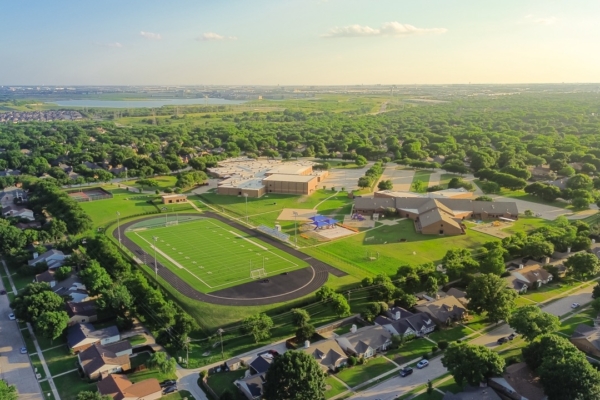Chinese people value education, especially when it comes to providing their children with access to good schools. They hope for schools with high-quality teachers and students. However, buying property in a good school district in the United States is not an easy task. Apart from the high prices, there is often stiff competition and bidding wars with other buyers. Despite this, there are still some affordable properties within good school districts. So, how can one find these lower-priced homes? Let’s explore this topic together in this episode.
Many people prefer buying homes in school districts because it enables their children to attend top-rated public elementary and high schools. Moreover, living in a good school district often means residing in a neighborhood with better overall quality. It may have better safety, cleanliness, and neighbors with higher standards. Additionally, properties in good school districts typically experience higher appreciation and preservation of value compared to surrounding areas.
On the flip side, the drawback of school district homes is their prices. According to a recent report from Realtor.com, properties located within the boundaries of schools with ratings of 9 to 10 tend to have average prices that are 78.6% higher than properties in the same county. This report uses the Great Schools system for school ratings.
The report identifies the top-rated schools in the U.S. and compares property prices in those school districts with the average prices in the respective counties. Generally, in the western region, the average prices of properties in good school districts are 87.4% higher than county prices; in the northeast, it’s 56% higher; in the Midwest, it even reaches 93.2% higher; and in the south, it’s 76.7% higher.
Another report by the renowned children’s equipment manufacturer Chicco states that properties near high-scoring public schools are priced nearly $300,000 higher than the national average. For the best school districts in each state, this difference can escalate to 86%. This report uses the Niche system to evaluate schools and Zillow’s database for property prices.
However, this second report not only uses different databases but also offers a comparison specifically focusing on properties in good school districts. A school district refers to an educational unit that usually encompasses multiple schools from kindergarten through high school grades. In the U.S., school districts are considered independent government entities, and school district board members can be elected by voters.
The most expensive school districts in the U.S. are ranked based on property prices. The top-ranked district is in Texas, the Eanes Independent School District in Austin. Property prices in this district are a whopping 486% higher than the Texas average. The average home price in Texas is around $290,000, while in the Eanes district, it reaches approximately $1.72 million.
In Missouri, the Ladue School District in St. Louis sees property prices exceed the state’s average by about $810,000, reaching around $1.05 million, marking a 346% increase. Similarly, in Connecticut, the Westport School District witnesses a 332% hike in property values compared to the state’s average selling price of nearly $380,000. To live in such premier school districts demands a hefty price tag.
California’s Palo Alto Unified School District ranks fourth, with property prices in the region, notably attended by former NBA player Jeremy Lin during his high school years, reaching a staggering $3.03 million – 308% higher than the California average. High prices are a common trend in top-tier school districts.
In Ohio, the Indian Hill Exempted Village School District sees a 198% surge in property prices compared to the state average. With Ohio’s average home price around $210,000, buyers seeking access to this prestigious district must be prepared to shell out nearly $640,000. These are the top five priciest school districts across various states in the U.S.
Looking at individual schools, both elementary and high schools exhibit varying price differentials. Generally, homes near top-rated elementary schools command prices 65% above the state average, whereas those near top high schools have price premiums around 45%. Living near a reputable elementary school may come at a higher cost than residing near a top high school.
The most expensive schools in Connecticut, West School and New Canaan High School, see property prices 359% higher than the state average of approximately $380,000, requiring around $1.35 million for a house purchase.
While acquiring property within premier school districts can be exorbitant, there are exceptions where certain districts offer lower real estate prices. For instance, Texico Municipal Schools in New Mexico sell homes approximately 45.58% cheaper than the state average at just under $160,000.
Athens Public Schools in Maine and Cheyenne Mountain School District No. 12 in Colorado boast property prices 43.86% and 28.68% lower than their respective state averages. These districts provide opportunities for affordable housing options amidst the broader trend of rising property costs in top-rated areas.
Moving on to elementary schools, some lesser-known districts also offer relatively lower property prices. Rising Leaders Academy in Florida, University Laboratory School in Hawaii, Roosevelt Public School in New Jersey, Nursery Elementary School in Texas, and Washington Yu Ying Public Charter School in Washington D.C. all present homes priced below their state averages by various percentages.
Although it might seem surprising that homes in highly rated school districts are sometimes priced lower, this can be attributed to factors like distance from the city, making lifestyle inconveniences a trade-off for lower property prices. Additionally, some exceptional schools might be situated in less desirable districts, impacting property values despite the school’s high standing. Parents who prioritize certain schools while being willing to accept external factors can benefit from reduced housing costs.
Nevertheless, most homes in well-reputed districts remain costly. To find lower-priced alternatives, buyers can consider compromising on certain amenities like a swimming pool, basement, garage, fireplace, or central air conditioning. Factors such as property size and age also play a role in pricing, with smaller and older homes generally being more budget-friendly. Ultimately, buyers must decide which features to prioritize and where to make concessions to save money.

